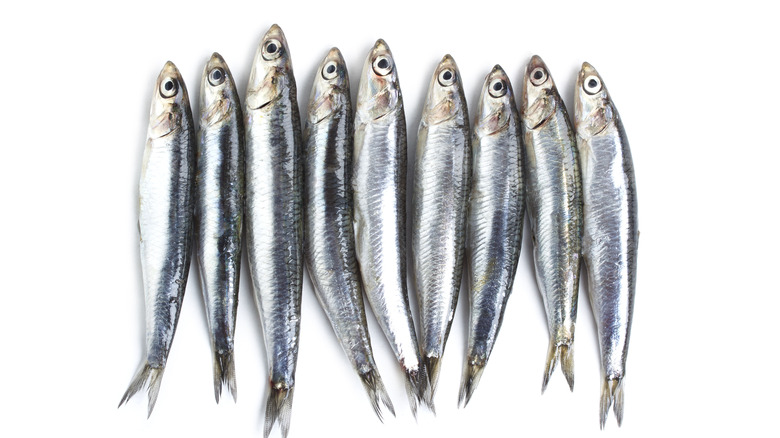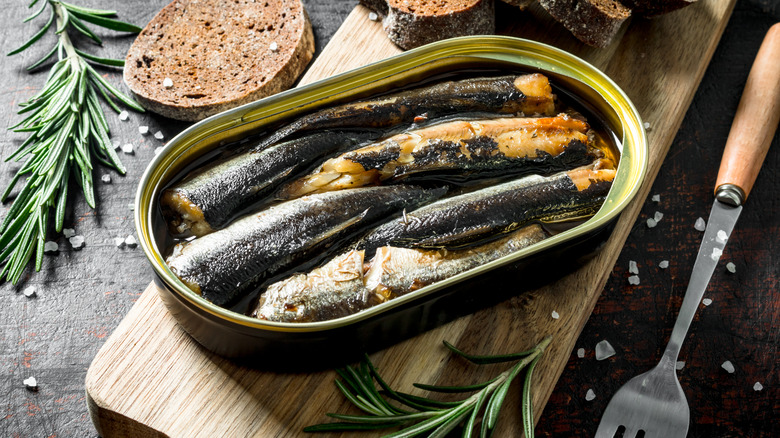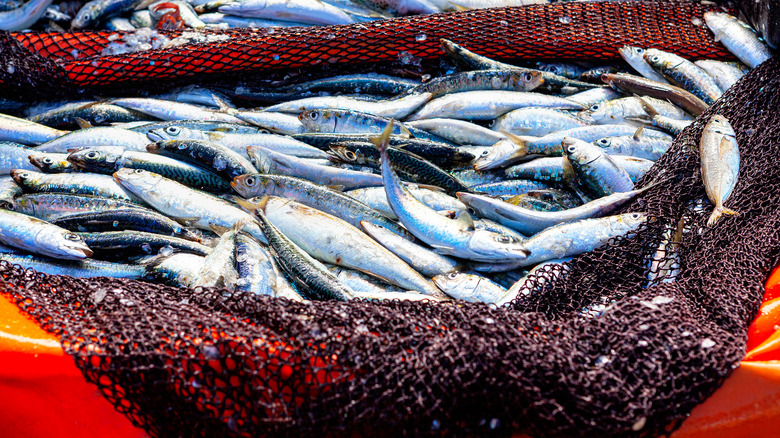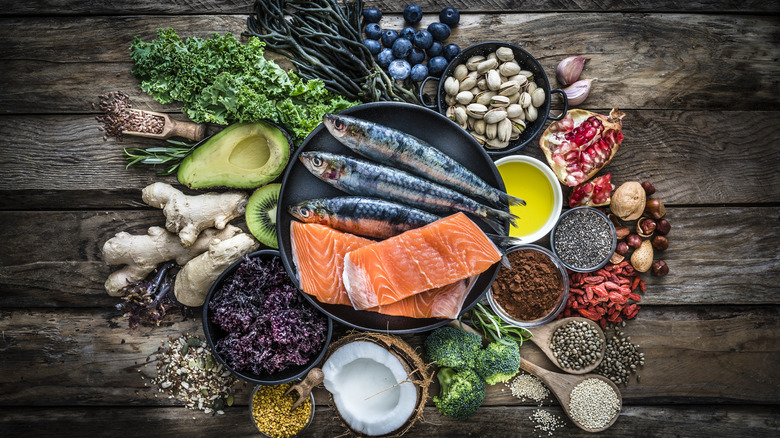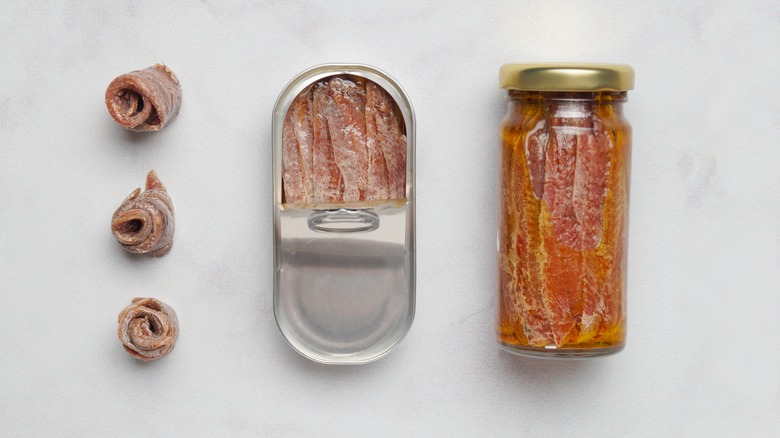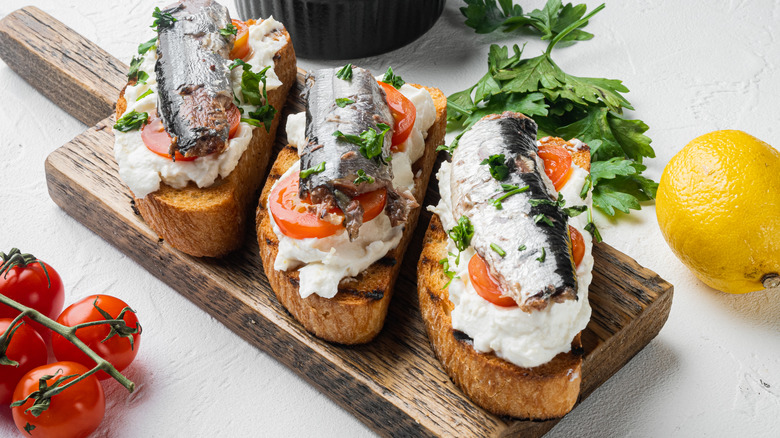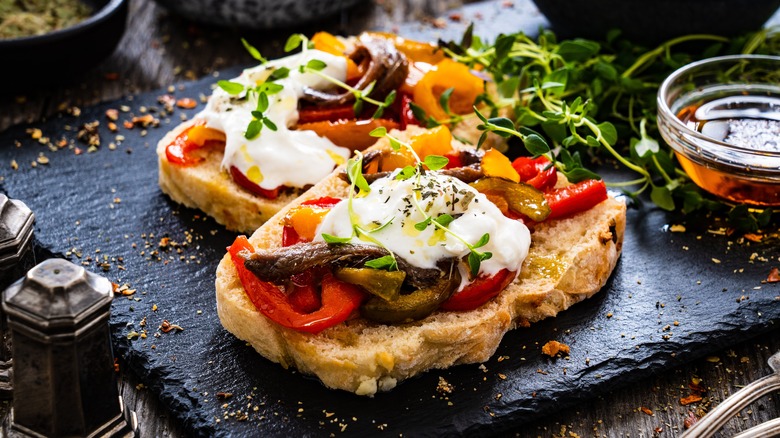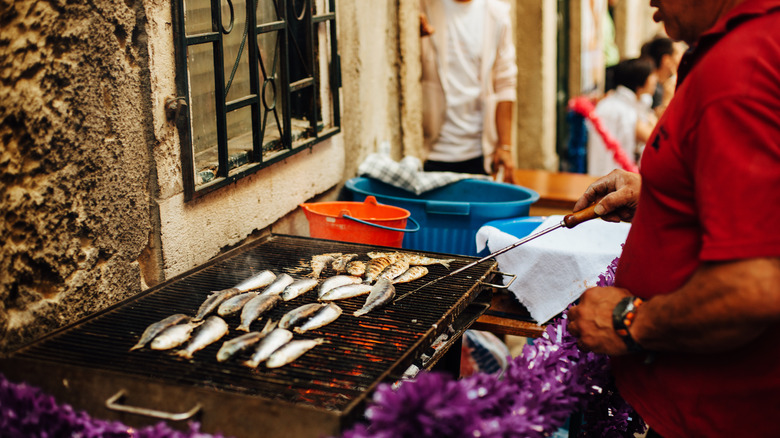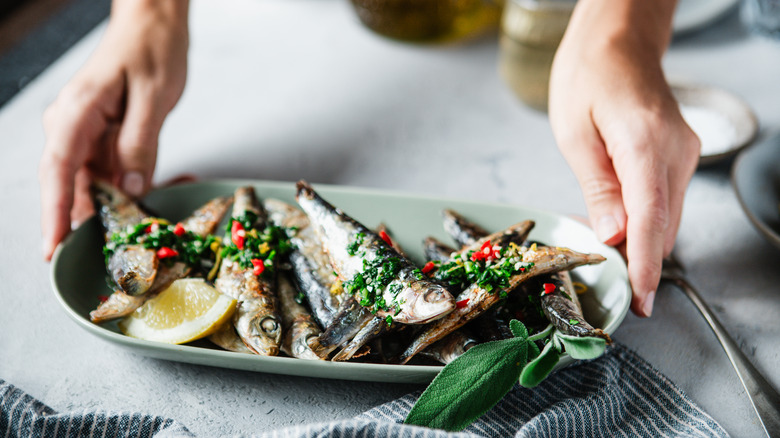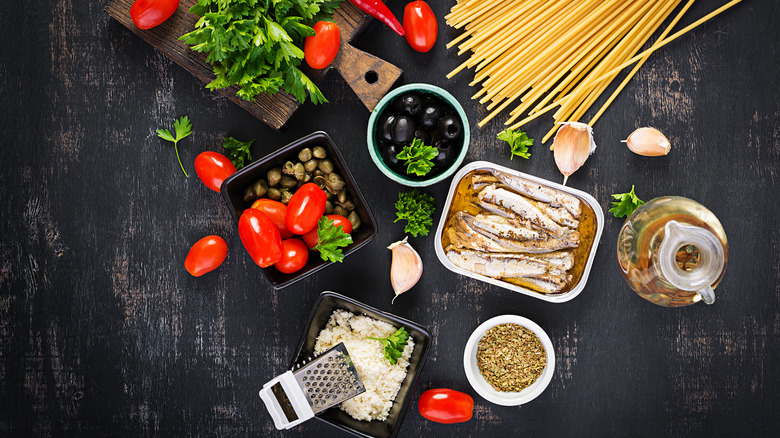The Salty Difference Between Sardines And Anchovies
Ah, the humble sardine and anchovy. These staples of the Mediterranean have found their way into pantries around the world — and for good reason. "Good food is very often, even most often, simple food," the late Anthony Bourdain once shared. We can imagine him on his travels in "Parts Unknown," indulging in simple meals like grilled sardines or a no-frills Italian pasta laced with anchovies.
These inexpensive and abundant fish, the once-celebrated food of the working class, are not to be overlooked. They're incredibly healthy. One of these fish fulfills your recommended daily allowance of omega-3 fatty acids, just like that (via Healthline). But what is different about sardines and anchovies? Well, the level of salt to begin with. Anchovies are cured in salt, so they win hands down when it comes to their salty goodness. Sardines and anchovies also look different from one another, with different texture. If you're lucky, you can enjoy both fish fresh off the docks — but they'll likely get to you in a tin can. And wouldn't you know, TikTok has made canned fish cool again. Let's walk you through the differences between sardines and anchovies so you'll be better prepared to use them in a variety of wonderful dishes.
How to tell sardines and anchovies apart
When it comes to fish, anchovies and sardines are both small fry. They're simple, silver fish but the anchovy is much smaller and slender than the chunkier sardine — and its silver scales have a bluish-green tinge. It measures 4 to 10 inches long, while the sardine is 6 to 12 inches. But it's how they're processed, packaged, and ultimately how they taste, that truly sets them apart.
The easiest way to tell the difference between an anchovy and a sardine is by how they look when they reach you. Anchovies are skinned nine times out of 10. And it's a slight, delicate fish. In the supermarket, they're predominantly sold in a compact glass jar. If you try to "fish" one out of the jar, with a fork, it will likely break in two. Sardines are tinned, like pilchards (they're the same species). You know the saying: "They were packed in like a tin of sardines?" Remember that when trying to tell the difference. You'll find sardines in a flat, rectangular tin, either packed in oil or water. Celebrity chef Alton Brown is a big advocate for tinned fish. For the best taste, he recommends buying tinned sardines in oil.
Where they're found and how they're fished
In terms of habitat, these fish aren't quite neighbors. Sardines thrive in temperate waters, preferring cooler environments. Think South Africa and the eastern Mediterranean. Anchovies prefer warmer waters, thriving in slightly higher temperatures. The European anchovy is the most popular kind and the one likely to be found on the shelf in your local supermarket. Sardines are exclusively found in saltwater environments, while anchovies have a more versatile habitat range. Anchovies can adapt to various aquatic conditions. You'll find them not only in saltwater but also in freshwater and brackish water.
It's the light of the moon, (or failing that, a lamp) that lures schools of anchovies to the surface of the water at night. That's when fishermen will scoop them up using a gill net. It's nighttime when sardines too, are harvested. In their case, a purse net is used to round them up, closing at the mouth, like a purse. Sardines are widespread around the world. You'll find them on the Pacific coast, the Gulf of Mexico, Mediterranean (Spain, Italy and Greece), Peru, Chile, and the west coast of Africa. Anchovies are found in the Black Sea, the Pacific, and Atlantic, as well as the Mediterranean.
When it comes to nutritional value, they pack a punch
Does seafood make you smarter? "Since 60% of the brain's building block is fat, it's essential to keep the brain fueled with DHA and EPA," registered dietitian nutritionist Amy Gorin shared with HuffPost. Canned sardines pack a punch when it comes to nutrition. They're not just rich in protein, vitamin B12, vitamin D, and calcium (providing more than 20% of your Daily Value), but they're also a solid source of iron (supplying more than 10% DV). "Omega-3 fatty acids such as EPA and DHA are key micronutrients that enhance and protect the brain," Debora Melo van Lent, a postdoctoral research fellow at the Biggs Institute, shared regarding a 2022 study. "... if you increase your consumption of omega-3s even by a little bit, you are protecting your brain."
Sardines contain close to 100% of the recommended daily intake of omega-3 fatty acids. It's recommended to eat about 8 ounces of seafood a week (via the U.S. Food and Drug Administration). But it's the little anchovy that trumps the sardine, having slightly more omega-3s, B vitamins, and minerals than sardines, and are slightly lower in fat and cholesterol (per Patagonia). Either way, whether you're choosing anchovies or sardines ... you're winning!
Anchovies and sardines don't taste the same
In the case of the anchovy, dynamite comes in small packages. Anchovies are known for their saltiness. This is because they are cured with salt, imparting a stronger, more pronounced fish flavor. When cooking with anchovies, a little goes a long way. And predominantly, this is how this little fish is used, to accentuate and deepen the flavor of other dishes. Think: Less is more.
The sardine, on the other hand, is served as the hero of the dish. This main ingredient is commonly stored in olive oil or can be bought fresh from a fishmonger. The sardine has a gentle, well-rounded taste. "They're pretty neutral, and you can do a lot with them, and they can be cheap but also fancy," says cookbook author Anna Hezel. Umami has been used to describe anchovies. It's the fifth taste, a combination of sweet, sour, bitter, and salty flavors.
Texturally, they're not in the same boat either
In the texture department, anchovies and sardines are poles apart. A novice would be able to tell the difference between the two if blindfolded. Anchovies have a wet, slippery texture. Sardines are texturally more dry in the mouth and flaky. Anchovies are light on the tongue, sardines are dense. When you add anchovies to a pasta sauce, for instance, it brings a salty undertone and depth of flavor. What happens is the little fillets melt away in the pan — essentially, they disintegrate. You won't find evidence of the anchovy in the sauce, it's just a background flavor. The more robust sardine will never dissolve away. It breaks up into flakes of fish. The sardine has a meatier texture whereas the anchovy is more soft and buttery.
"A big smudge of anchovy paste will add incredible depth and a wonderful clingy texture to the finished product," Jess Kapadia explains in her article Should I Use Anchovy Paste or Fillets? Go for the paste if you want to "thicken" a sauce up a little. Also, if you're buying the tinned or jarred variety, there are two types of anchovies. There's nothing wrong with either option, they're both great. You'll either find a brownish-purple fillet that breaks up in your fingers or a more white, firm-fleshed fish (this one is great for an open sandwich).
Are these two fish interchangeable in certain dishes
Sardines are the primary ingredient in a recipe, while anchovies are more commonly the base or supporting flavor. Because of this, when it comes to cooking with them, they are not interchangeable. But there is one exception. The open sandwich. Take a look at this sardine sandwich recipe. Now take a look at this anchovy on garlic bread recipe. Both these fish can be celebrated with a hunk of fresh bread and butter. A bonus is the oil you'll find in the tin or jar that the fish may have come in, drizzle a little on top and you've got a gourmet snack.
Anchovies are not interchangeable when you're using them to flavor a dish. The bottom line is that sardines cannot flavor a dish the way an anchovy can. And using an anchovy as a stand-in for a sardine flavor would overpower the dish. Opt for a flavorful choice, but less intense flavor, such as tinned tuna.
Where you'll find these fish in dishes around the world
Did you know sardines were named after Sardinia? They were once abundant in the Mediterranean waters around the large Italian island. They are still celebrated on the island with traditional recipes like Sarde a Beccafico, where the sardines are stuffed with raisins, pine nuts and bread crumbs, before being baked. In Portugal, the month of June is littered with festivals celebrating saints. But it's the festival of Saint Anthony on June 13 where the smoky aroma of barbecued sardines permeates the streets of Lisbon. Sardines are significant to the festival because it's believed a shoal of sardines once stopped swimming to listen to the Saint give a sermon. June is also the start of the Portuguese sardine fishing season which runs until October.
Next time you're in France, or a French region, enquire about Pissaladière. This Provence-style flatbread is decorated with caramelized onions, olives, and anchovies and is often compared to a pizza. Northern Spain is also known for its anchovies. In his series, "Rick Stein's Spain", the charming TV chef sings the praises of the anchovies of the Cantabrian sea and the factories that so diligently can it. In episode two, he uses the salted Spanish delicacy to make a delicious summer salad.
The celebrity chefs who love to use these fish and why
Across the waters, in the United Kingdom, Nigella Lawson naturally has a romantic vision of the humble sardine: "There is something about fresh, really fresh, grilled sardines that reminds me instantly of those long holiday lunches in rented summer houses abroad." And one of our favorite Italian chefs, Food Network star Giada De Laurentiis, reassures us that anchovies are used prominently all over Italy. "In Italian cooking, anchovies are extremely common. They don't add so much of a "fishy" taste as much as a salty, umami punch of flavor. For that, I always keep anchovy paste, oil, or filets on hand to give pasta dishes ... a boost of flavor," she shared on her website Giadzy.
Jamie Oliver shared a picture of "the most amazing" anchovies on toasted sourdough on his Instagram account. Apparently, anchovies on toast was the preferred breakfast of Rose Grey, the co-founder of the famous River Cafe. Alton Brown of "Iron Chef" fame loves tinned sardines so much he has a fish bank at home — "an entire shelf dedicated to storing canned fish."
How to make sardines the hero of your next meal
Sardines are considered peasant food because they're such an abundant and inexpensive fish. But don't skip over this unassuming gem next time you're choosing fish. If you can get them fresh, we recommend enjoying sardines as the hero of the dish. Take a leaf from the Portuguese's book and grill them. Make this the first meal of your summer. Get outside, light up the grill, and follow this recipe for sardines, charred lemon and chiles.
If tinned sardines are all you can get your hands on, fear not. Foodie Jess Kapadia reckons there are only two great ways to eat a sardine. One is freshly caught in the Mediterranean, and the other is her great-grandfather's sardine sandwich with cream cheese. We won't lie, it had us salivating. Now, if you find yourself traveling the Mediterranean or in a place where there are glistening sardines available off a boat, then Zakary Pelaccio's Pasta Con Sarde is the meal you need to make. "The smell of the fennel and the sardines cooking, simmering together along with tomatoes and raisins, is hypnotic," he says of this Sicilian dish.
How to up-level what's coming out of your kitchen with anchovies
To begin with, you have to have the little jar of anchovies in your fridge. It's such an obscure ingredient that it's easy to overlook as a pantry staple. You'll find an opportunity to use it (think pizza topping, pasta sauce, or caesar salad) and if you don't have this unique ingredient at hand, add it to your shopping list and give it pride of place alongside mustard, capers, and tube of tomato paste.
There is a debate about whether to use anchovy paste or fillets. You can't go wrong with either. However, the little fillets may be more versatile if you want to add anchovy to a pizza, for instance (a favorite combination is mushrooms, olives, and anchovies — salty much?) You can also use whole anchovies in a pasta dish like the traditional Puttanesca or this seared scallops recipe that's a good option for communal dining. Chef Jacob Kenedy of Bocca di Lupo in London suggests the use of anchovies in the most simple pasta Aglio e Elio. "Fry garlic gently in oil, add a little chili, then some chopped anchovy fillets. Stir off the heat until the fillets melt, then toss in the pasta, some parsley, and a little cooking water." Simple but delicious. Roll up your sleeves and get experimenting!

